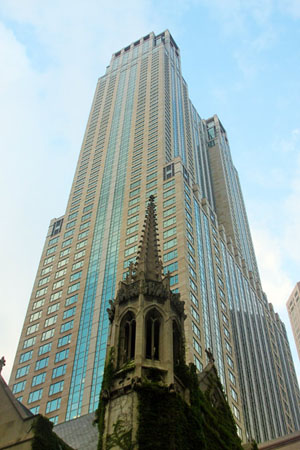 Controlling perspective is often difficult in architectural photography. Buildings and other structures that make interesting subjects are often very large, and photographers typically work close to ground level. This means that a photographer must angle a camera upward, so that the plane of the subject is no longer parallel with the plane of the film or sensor. This produces converging vertical lines. Converging verticals can be appropriate for some images, and the phenomenon can even be used or exaggerated to emphasize the height of a tall building, but in many cases a better image may be obtained by controlling or correcting perspective effects.
Controlling perspective is often difficult in architectural photography. Buildings and other structures that make interesting subjects are often very large, and photographers typically work close to ground level. This means that a photographer must angle a camera upward, so that the plane of the subject is no longer parallel with the plane of the film or sensor. This produces converging vertical lines. Converging verticals can be appropriate for some images, and the phenomenon can even be used or exaggerated to emphasize the height of a tall building, but in many cases a better image may be obtained by controlling or correcting perspective effects.
In the image opposite, the vertical lines converge towards the top of the building. This is not distortion but the logical consequence of photographing a large structure at such an oblique angle. A row of six or eight windows at the base of the building is much closer to the camera that a comparable row at the top of the building. The row of windows consequently appears progressively shorter as the building rises.
Photograph the building from close to the base with a wide-angle lens and the walls may appear to bulge as the vertical lines curve upwards. Unless this effect is intended as a feature of an image, it is usually best avoided.
One way to avoid or reduce unwanted perspective effects is to use a telephoto lens from a much greater distance. As the distance from the subject increases, so the distance from photographer to the top and the bottom of a building tend to equalize. This renders the building near upright with vertical lines approaching parallel. Closer up, the best way to control perspective is by using a perspective-control (PC) lens (shift lens) designed specifically for this purpose. Of course Photoshop can be used to make final corrections if necessary.